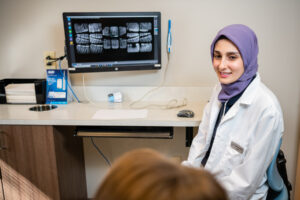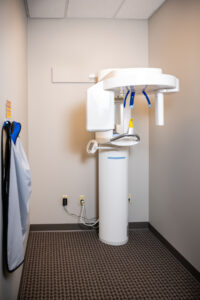The “What” and “Why” of X-rays:

If you’ve been to a dental office, odds are you’ve had x-rays taken of your mouth and teeth. Your dentist and hygienist use x-rays to get information about your oral health that may not be readily detectible with an exam alone. X-rays can reveal tooth decay and other problems that can’t be seen with the naked eye.
Scientifically, x-rays are a kind of wave with high energy, called radiation, that is able to pass through certain materials or objects. X-ray technology measures how far these waves penetrate into a material to create an image of the object in question. This image is called a radiograph.
———
The Four Different Types of X-rays at All Smiles:
There are four different kinds of dental x-rays we take here at All Smiles Family Dentistry, and each type has a unique purpose.
- Bitewing x-rays take a picture of the tops of your back teeth, and also show how your upper and lower teeth bite together. Four bitewings, two on each side of the mouth, are needed to get images of all of an adult’s premolars and molars. Depending on age and number of adult teeth, children may need between two and four bitewings. This type of x-ray is usually taken once a year at regular check-ups.
- Periapical x-rays (or PA’s) take a picture of an entire tooth in high detail. These x-rays are vital in diagnosing most problems with individual teeth, as they reveal every structure within and close to the target tooth. Two PA’s are taken usually once a year at regular check-ups to get images of the front teeth, top and bottom.
- Panoramic x-rays take a picture of the whole mouth in one exposure, revealing wisdom teeth that may not have erupted from the gums or are too far back for bitewings or PA’s to see. “Pano” x-rays can also show the nerves of the face and jaw. This type of x-ray is a necessity when diagnosing wisdom teeth that need to be extracted, and is often taken if you still have your wisdom teeth or are not able to tolerate a full-mouth series of inside-the-mouth x-rays.
- Cone beam (CBCT) scans are three-dimensional images that show the entire jaw and mouth in high detail. These radiographs are especially useful when diagnosing issues with the jaw joint and are helpful in placing dental implants, creating plans for wisdom tooth extractions, and performing root canals.
All of the x-rays we take at All Smiles are digital, as opposed to traditional film x-rays. Digital x-rays expose you to much less radiation (around 75% less!), and you don’t have to wait for the picture to develop like with film. The majority of patients also find the process of getting digital x-rays to be more comfortable than film.
———
X-ray Safety and Protection:

The radiation dose you receive from dental x-rays should not worry you, and numerous studies have shown that dental x-rays do not lead to an increase in cancer. However, there are certain areas of the body that are considered more sensitive to radiation, like the thyroid, a gland in the neck important for hormones and metabolism. Since dental x-rays are focused at your head and neck area, the thyroid has high priority for radiation protection.
Up-to-date evidence supports the use of a thyroid guard or collar instead of a full-torso protective apron when taking x-rays inside the mouth. We still, however, have the traditional aprons for patients that gain peace of mind from the protective feeling of the heavy apron. For panoramic and CBCT x-rays, we continue to use an apron since the radiation dose for this type of x-ray is higher than those taken inside the mouth.
Nothing is more important than the health and wellbeing of our patients. All Smiles Family Dentistry ensures the x-rays we take are as comfortable, accurate and safe as possible.
